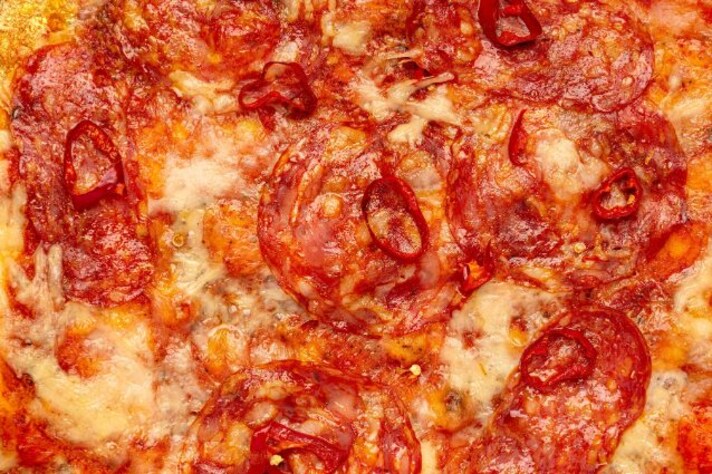When Should You Put Tomato on Homemade Pizza? What About Mozzarella Cheese? Here’s Everything You Need to Know
Tomato is the first ingredient to add on homemade pizza. Mozzarella halfway through cooking. For the other ingredients it depends. Watch out for humidity however: products with too much liquid can ruin the dough.

When making homemade pizza, the correct order of adding the ingredients is essential to get the best result, especially when it comes to mozzarella and tomato, the main protagonists of the Margherita pizza. Let's see in detail when and how to add each ingredient to get a perfectly cooked and tasty pizza.
When Should You Add Tomato to Your Pizza?

Tomato is the first ingredient to add. After rolling out the dough, spread the tomato sauce evenly. The tomato is added before cooking because it needs to cook and release its flavors into the dough (yes, the flavor penetrates). Typically, a simple sauce is used, based on puree or peeled tomatoes, seasoned with salt, oil and, if desired, a little basil or oregano. Adding the tomato at the beginning of cooking allows you to obtain a moist base but not too liquid, helping to prevent the dough from drying out. It also helps the cooking of the pizza because there is a risk that the dough will burn if exposed to too much heat.
When Should You Add Mozzarella Cheese, Instead?

Mozzarella should be added halfway through cooking or in the last few minutes to prevent it from melting too quickly and releasing too much water, making the pizza too wet. If you use buffalo mozzarella, which contains more liquid than fior di latte, it is even more important to add it towards the end of cooking. Before placing it on the pizza, drain it well to reduce excess liquid. The trick is to obtain a stringy and creamy mozzarella, without soaking the pizza.
In pizzerias, mozzarella is added immediately before cooking, for a series of reasons related to the efficiency, quality and operation of the professional oven. Pizzeria ovens reach very high temperatures, often between 752°F and 932°F (400 °C and 500 °C) . At these temperatures, the pizza cooks very quickly, usually in 60-90 seconds. In this short time, the mozzarella manages to melt perfectly without releasing too much water and without burning. The speed and power of the oven avoid the problems that are encountered at home with ovens at lower temperatures. In home preparation, cooking times are often longer and temperatures lower than in professional ovens, so it is possible that the mozzarella will dry out if added too early. This is why, in some home recipes, it is recommended to add it towards the end of the cooking process or in the last few minutes, so as to preserve its creaminess without compromising the final result.
How to Avoid Mistakes With Mozzarella and Tomato
Often, those who make pizza at home complain about a pizza that is too moist. This happens especially because of excess liquid, due to mozzarella or tomato that aren't well managed. Draining the mozzarella well and distributing the tomato evenly without overdoing it are key steps for a well-balanced pizza. If you want an even drier pizza, try cooking the dough with only the tomato for a few minutes before adding the mozzarella.
When Should You Put Other Ingredients on Your Pizza?

When making a homemade pizza, knowing when to add the ingredients plays a fundamental role in obtaining an optimal result. Unlike professional pizzerias, where the ovens reach extremely high temperatures, domestic ovens usually do not exceed 482°F (250°C) . This means that the cooking times and methods of the ingredients must be regulated more carefully. Generally speaking, we can say that raw ingredients such as rocket, prosciutto, basil or parmesan flakes are added after cooking. These ingredients must remain fresh and crunchy, so they must not be exposed to the heat of the oven; cooked ingredients such as grilled vegetables, sausage or cured meats such as salami or bacon are added before cooking, together with the tomato. However, always check the cooking time to avoid burning them. Especially with cured meats you have to be very careful because the salami risks being too salty.
A General List of Indications to Follow
The ingredients on pizza can be divided into two categories: those that require cooking and those that are best added at the end to preserve their flavor and texture.
- Raw vegetables (such as mushrooms, zucchini, onions, peppers): before cooking. It is recommended to add them at the beginning, but in moderation. These vegetables release a lot of water, and too much moisture could compromise the crispiness of the dough. A trick is to grill them or lightly sauté them in a pan before putting them on the pizza.
- Raw meat (such as sausage or bacon) should be added before cooking, so that it releases its fat and flavors the rest of the pizza.
- It is best to add cured meats (such as prosciutto or bresaola) after cooking, because the heat would dry them out excessively.
- Creamy cheeses like burrata or stracciatella should be added after cooking to maintain their fresh, creamy consistency.
- Hard cheeses such as Parmesan can be grated onto the pizza either before or after baking, depending on your preference for flavor intensity.
- Fresh herbs (basil, rocket) : These are more delicate and are usually added after cooking to prevent the heat from burning or wilting them, ruining their fresh flavor.
One of the most common problems in homemade pizzas is the excess liquid released by the ingredients, which can make the base too moist and soft. We must therefore take some precautions such as a well-drained and drier mozzarella, you can also obtain it thanks to a strainer (left there for at least half an hour) or dried with absorbent paper. If you use fresh tomatoes instead, cut them in half and remove the seeds to reduce the water.
;Resize,width=767;)
;Resize,width=712;)
;Resize,width=712;)

